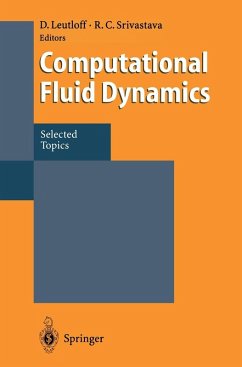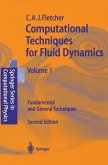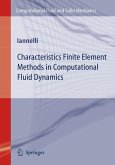Computational Fluid Dynamics (eBook, PDF)
Selected Topics
Redaktion: Leutloff, Dieter; Srivastava, Ramesh C.
40,95 €
40,95 €
inkl. MwSt.
Sofort per Download lieferbar

20 °P sammeln
40,95 €
Als Download kaufen

40,95 €
inkl. MwSt.
Sofort per Download lieferbar

20 °P sammeln
Jetzt verschenken
Alle Infos zum eBook verschenken
40,95 €
inkl. MwSt.
Sofort per Download lieferbar
Alle Infos zum eBook verschenken

20 °P sammeln
Computational Fluid Dynamics (eBook, PDF)
Selected Topics
Redaktion: Leutloff, Dieter; Srivastava, Ramesh C.
- Format: PDF
- Merkliste
- Auf die Merkliste
- Bewerten Bewerten
- Teilen
- Produkt teilen
- Produkterinnerung
- Produkterinnerung

Bitte loggen Sie sich zunächst in Ihr Kundenkonto ein oder registrieren Sie sich bei
bücher.de, um das eBook-Abo tolino select nutzen zu können.
Hier können Sie sich einloggen
Hier können Sie sich einloggen
Sie sind bereits eingeloggt. Klicken Sie auf 2. tolino select Abo, um fortzufahren.

Bitte loggen Sie sich zunächst in Ihr Kundenkonto ein oder registrieren Sie sich bei bücher.de, um das eBook-Abo tolino select nutzen zu können.
This topical volume presents articles on turbulent boundary layers, the Tsunami problem, group invariant solution of hydrodynamic equations, non-linear waves, modelling of the problem of evaporation-condensation, the exact solution of discrete models of the Boltzmann equation etc. Written by experts in their fields, it addresses researchers and engineers in the mechanical sciences and numerical analysts.
- Geräte: PC
- ohne Kopierschutz
- eBook Hilfe
- Größe: 31.46MB
Andere Kunden interessierten sich auch für
![Computational Techniques for Fluid Dynamics 1 (eBook, PDF) Computational Techniques for Fluid Dynamics 1 (eBook, PDF)]() Clive A. J. FletcherComputational Techniques for Fluid Dynamics 1 (eBook, PDF)60,95 €
Clive A. J. FletcherComputational Techniques for Fluid Dynamics 1 (eBook, PDF)60,95 €![Computational Fluid Dynamics 2000 (eBook, PDF) Computational Fluid Dynamics 2000 (eBook, PDF)]() Computational Fluid Dynamics 2000 (eBook, PDF)112,95 €
Computational Fluid Dynamics 2000 (eBook, PDF)112,95 €![Fundamentals of Computational Fluid Dynamics (eBook, PDF) Fundamentals of Computational Fluid Dynamics (eBook, PDF)]() H. LomaxFundamentals of Computational Fluid Dynamics (eBook, PDF)46,95 €
H. LomaxFundamentals of Computational Fluid Dynamics (eBook, PDF)46,95 €![Characteristics Finite Element Methods in Computational Fluid Dynamics (eBook, PDF) Characteristics Finite Element Methods in Computational Fluid Dynamics (eBook, PDF)]() Joe IannelliCharacteristics Finite Element Methods in Computational Fluid Dynamics (eBook, PDF)160,95 €
Joe IannelliCharacteristics Finite Element Methods in Computational Fluid Dynamics (eBook, PDF)160,95 €![Computational Techniques for Fluid Dynamics 2 (eBook, PDF) Computational Techniques for Fluid Dynamics 2 (eBook, PDF)]() Clive A. J. FletcherComputational Techniques for Fluid Dynamics 2 (eBook, PDF)68,95 €
Clive A. J. FletcherComputational Techniques for Fluid Dynamics 2 (eBook, PDF)68,95 €![Parallel Computational Fluid Dynamics 2008 (eBook, PDF) Parallel Computational Fluid Dynamics 2008 (eBook, PDF)]() Parallel Computational Fluid Dynamics 2008 (eBook, PDF)112,95 €
Parallel Computational Fluid Dynamics 2008 (eBook, PDF)112,95 €![Computation of Unsteady Internal Flows (eBook, PDF) Computation of Unsteady Internal Flows (eBook, PDF)]() Paul G. TuckerComputation of Unsteady Internal Flows (eBook, PDF)112,95 €
Paul G. TuckerComputation of Unsteady Internal Flows (eBook, PDF)112,95 €-
-
-
This topical volume presents articles on turbulent boundary layers, the Tsunami problem, group invariant solution of hydrodynamic equations, non-linear waves, modelling of the problem of evaporation-condensation, the exact solution of discrete models of the Boltzmann equation etc. Written by experts in their fields, it addresses researchers and engineers in the mechanical sciences and numerical analysts.
Dieser Download kann aus rechtlichen Gründen nur mit Rechnungsadresse in A, B, BG, CY, CZ, D, DK, EW, E, FIN, F, GR, HR, H, IRL, I, LT, L, LR, M, NL, PL, P, R, S, SLO, SK ausgeliefert werden.
Produktdetails
- Produktdetails
- Verlag: Springer Berlin Heidelberg
- Seitenzahl: 287
- Erscheinungstermin: 6. Dezember 2012
- Englisch
- ISBN-13: 9783642794407
- Artikelnr.: 53139907
- Verlag: Springer Berlin Heidelberg
- Seitenzahl: 287
- Erscheinungstermin: 6. Dezember 2012
- Englisch
- ISBN-13: 9783642794407
- Artikelnr.: 53139907
- Herstellerkennzeichnung Die Herstellerinformationen sind derzeit nicht verfügbar.
Continuum Hypothesis in the Computation of Gas-Solid Flows.- 1. Introduction.- 2. Governing Equations.- 3. Numerical Procedure.- 4. Numerical Results.- 5. Conclusions.- Numerical Modelling of Two- and Three-Dimensional External and Internal Unsteady Incompressible Flow Problems.- 1. Introduction.- 2. The Mathematical Model - The Governing Equations.- 3. The Numerical Solution Method.- 4. The Solution of the Equation Systems (3.9) and (3.10) - Solvability Conditions.- 5. The Application of the Solution Methods to Crystal Melt Flow.- 6. The External Flow Around a Cylinder.- Numerical Experiments in Double-Diffusive Convection.- 1. Introduction.- 2. The Motion Equations and Their Numerical Solution.- 3. Lateral Heating of a Stratified Fluid.- 4. Conclusion.- New Potentialities of Computational Experiment in Tsunami Problem.- 1. Introduction.- 2. Basic Mathematical Models.- 3. Methodological Principles of Some Applied Problems of Tsunami by Computational Experiment.- 4. Computational Experiment Facilities Employed for the Training of the Tsunami Warning Service Personnel and of the Population in the Threatened Zones.- General Balance Equations for a Fluid-Fluid Interface in Magnetofluiddynamics Soubbaramayer.- 1. Introduction.- 2. MFD Model: Integral Conservative Form.- 3. Balance Equations for the Interface.- 4. Application to the Calculation of the Surface Depression in a High-Current Arc Weld Pool.- 5. Conclusion.- Group-Invariant Solutions of Hydrodynamics.- 1. Introduction.- 2. Lie Groups Applied to Differential Equations.- 3. Hydrodynamics Model.- 4. One-Dimensional Solutions.- 5. Two-Dimensional Solutions.- 6. 3-D Solutions.- 7. Analytic Solutions.- Survey on Exact Solutions for Discrete Models of the Boltzmann Equation.- 1. Introduction.- 2. Broad wellEquations.- 3. Models with 14 Velocities.- 4. Models with Triple Collisions.- 5. Two-Dimensional Semi-Continuous Model Ill.- 6. Conclusion.- Boundary Conditions for Discrete Models of Gases and Applications to Couette Flows Amah D'Almeida and Renée Gatignol.- 1. Introduction.- 2. Discrete Kinetic Theory.- 3. Boundary Conditions.- 4. Couette Flows.- 5. Results.- 6. Conclusion.- Computation of Viscous Transonic Flow Around the F5 Wing.- 1. Introduction.- 2. Governing Equations and Boundary Conditions.- 3. Numerical Method.- 4. Results.- 5. Conclusions.- A Time-Dependent Space Marching Algorithm for Three-Dimensional PNS Equations.- 1. Introduction.- 2. Governing Equations.- 3. The Flux-Difference Splitting.- 4. Explicit-Implicit Difference Scheme.- 5. Numerical Tests.- 6. Conclusions.- New Potential-Field Properties of General Laminar and Turbulent Motions of Newtonian Fluids.- I. Introduction.- 2. Physical and Mathematical Preliminaries.- 3. Derivation of Some Field Properties of NSE.- 4. Thermo dynamical Stability Criterion for Instationary Flows.- 5. The Instationary Turbulent Flow in Temporal Mean.- 6. Conclusion.- Boundary Layer Turbulence and the Control by Suction.- 1. Introduction.- 2. Flow Change with the Development of Boundary Layer.- 3. Discussion on Energy.- 4. Self-Organization of Turbulent Boundary Layer.- 5. Experiment on Control of Turbulent Boundary Layer.- 6. Conclusions.- On the Quasi-Geostrophic Drag on a Rising Sphere in a Rotating Fluid.- 1. Introduction.- 2. Solution.- 3. Results.- Two-Dimensional Nonlinear Saturation Behaviour of Instability Waves in a Boundary Layer at Mach 5.- 1. Introduction.- 2. Governing Equations.- 3. Numerical Method.- 4. Simulation Results.- 5. Perturbation Evolution.- 6. Evolution of the Flow Field.- 7. ShockIdentification.- 8. Conclusions.- Inertia! Convection in Turbulent Rayleigh-Bénard Convection at Small Prandtl Numbers.- 1. Introduction.- 2. Simulation Method.- 3. Case Specifications and Initial Data.- 4. Results.- 5. Conclusions.- The GRP Treatment of Flow Singularities.- 1. Tracking of Singularities.- 2. Geometrical Singularities.- 3. Narrow Reaction Zones in Combustion Calculations.- Application of the Multidomain Local Fourier Method for CFD in Complex Geometries.- 1. Introduction.- 2. Multidomain Local Fourier Method (MDLF).- 3. Problems in Complex Geometries.- 4. Preconditioned Iteration Method with Spectral Preconditioner.- 5. Demonstration for the Navier-Stokes System.- Confined Swirling Flows - A Continuing Challenge.- 1. Introduction.- 2. Statement of the Problem.- 3. Numerical Formulation.- 4. Results and Discussion.- 5. Conclusions.- Eshelbian Continuum Mechanics and Nonlinear.- 1. Introduction.- 2. Momentum and Pseudo-Momentum; Force and Pseudo-Force.- 3. Field Formulation.- 4. Non-Equivalence Between Global Formulations.- 5. The Role of Pseudomomentum and Energy in Nonlinear-Wave Propagation.- 6. A Newtonian Mechanics for Global Material Forces?.
Continuum Hypothesis in the Computation of Gas-Solid Flows.- 1. Introduction.- 2. Governing Equations.- 3. Numerical Procedure.- 4. Numerical Results.- 5. Conclusions.- Numerical Modelling of Two- and Three-Dimensional External and Internal Unsteady Incompressible Flow Problems.- 1. Introduction.- 2. The Mathematical Model - The Governing Equations.- 3. The Numerical Solution Method.- 4. The Solution of the Equation Systems (3.9) and (3.10) - Solvability Conditions.- 5. The Application of the Solution Methods to Crystal Melt Flow.- 6. The External Flow Around a Cylinder.- Numerical Experiments in Double-Diffusive Convection.- 1. Introduction.- 2. The Motion Equations and Their Numerical Solution.- 3. Lateral Heating of a Stratified Fluid.- 4. Conclusion.- New Potentialities of Computational Experiment in Tsunami Problem.- 1. Introduction.- 2. Basic Mathematical Models.- 3. Methodological Principles of Some Applied Problems of Tsunami by Computational Experiment.- 4. Computational Experiment Facilities Employed for the Training of the Tsunami Warning Service Personnel and of the Population in the Threatened Zones.- General Balance Equations for a Fluid-Fluid Interface in Magnetofluiddynamics Soubbaramayer.- 1. Introduction.- 2. MFD Model: Integral Conservative Form.- 3. Balance Equations for the Interface.- 4. Application to the Calculation of the Surface Depression in a High-Current Arc Weld Pool.- 5. Conclusion.- Group-Invariant Solutions of Hydrodynamics.- 1. Introduction.- 2. Lie Groups Applied to Differential Equations.- 3. Hydrodynamics Model.- 4. One-Dimensional Solutions.- 5. Two-Dimensional Solutions.- 6. 3-D Solutions.- 7. Analytic Solutions.- Survey on Exact Solutions for Discrete Models of the Boltzmann Equation.- 1. Introduction.- 2. Broad wellEquations.- 3. Models with 14 Velocities.- 4. Models with Triple Collisions.- 5. Two-Dimensional Semi-Continuous Model Ill.- 6. Conclusion.- Boundary Conditions for Discrete Models of Gases and Applications to Couette Flows Amah D'Almeida and Renée Gatignol.- 1. Introduction.- 2. Discrete Kinetic Theory.- 3. Boundary Conditions.- 4. Couette Flows.- 5. Results.- 6. Conclusion.- Computation of Viscous Transonic Flow Around the F5 Wing.- 1. Introduction.- 2. Governing Equations and Boundary Conditions.- 3. Numerical Method.- 4. Results.- 5. Conclusions.- A Time-Dependent Space Marching Algorithm for Three-Dimensional PNS Equations.- 1. Introduction.- 2. Governing Equations.- 3. The Flux-Difference Splitting.- 4. Explicit-Implicit Difference Scheme.- 5. Numerical Tests.- 6. Conclusions.- New Potential-Field Properties of General Laminar and Turbulent Motions of Newtonian Fluids.- I. Introduction.- 2. Physical and Mathematical Preliminaries.- 3. Derivation of Some Field Properties of NSE.- 4. Thermo dynamical Stability Criterion for Instationary Flows.- 5. The Instationary Turbulent Flow in Temporal Mean.- 6. Conclusion.- Boundary Layer Turbulence and the Control by Suction.- 1. Introduction.- 2. Flow Change with the Development of Boundary Layer.- 3. Discussion on Energy.- 4. Self-Organization of Turbulent Boundary Layer.- 5. Experiment on Control of Turbulent Boundary Layer.- 6. Conclusions.- On the Quasi-Geostrophic Drag on a Rising Sphere in a Rotating Fluid.- 1. Introduction.- 2. Solution.- 3. Results.- Two-Dimensional Nonlinear Saturation Behaviour of Instability Waves in a Boundary Layer at Mach 5.- 1. Introduction.- 2. Governing Equations.- 3. Numerical Method.- 4. Simulation Results.- 5. Perturbation Evolution.- 6. Evolution of the Flow Field.- 7. ShockIdentification.- 8. Conclusions.- Inertia! Convection in Turbulent Rayleigh-Bénard Convection at Small Prandtl Numbers.- 1. Introduction.- 2. Simulation Method.- 3. Case Specifications and Initial Data.- 4. Results.- 5. Conclusions.- The GRP Treatment of Flow Singularities.- 1. Tracking of Singularities.- 2. Geometrical Singularities.- 3. Narrow Reaction Zones in Combustion Calculations.- Application of the Multidomain Local Fourier Method for CFD in Complex Geometries.- 1. Introduction.- 2. Multidomain Local Fourier Method (MDLF).- 3. Problems in Complex Geometries.- 4. Preconditioned Iteration Method with Spectral Preconditioner.- 5. Demonstration for the Navier-Stokes System.- Confined Swirling Flows - A Continuing Challenge.- 1. Introduction.- 2. Statement of the Problem.- 3. Numerical Formulation.- 4. Results and Discussion.- 5. Conclusions.- Eshelbian Continuum Mechanics and Nonlinear.- 1. Introduction.- 2. Momentum and Pseudo-Momentum; Force and Pseudo-Force.- 3. Field Formulation.- 4. Non-Equivalence Between Global Formulations.- 5. The Role of Pseudomomentum and Energy in Nonlinear-Wave Propagation.- 6. A Newtonian Mechanics for Global Material Forces?.







